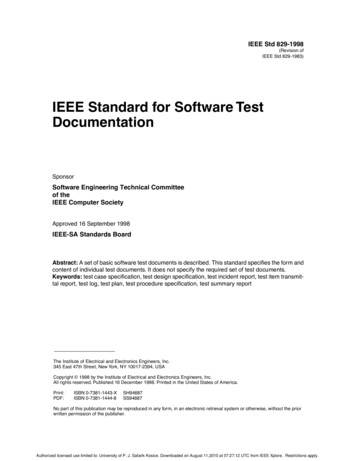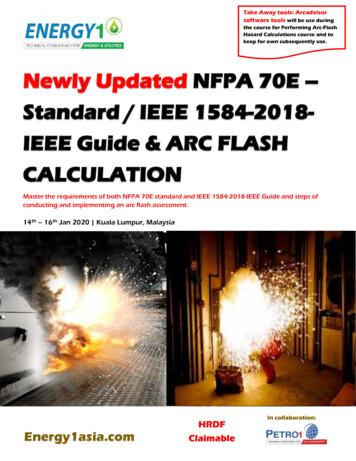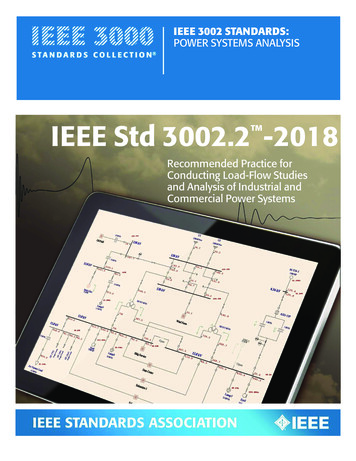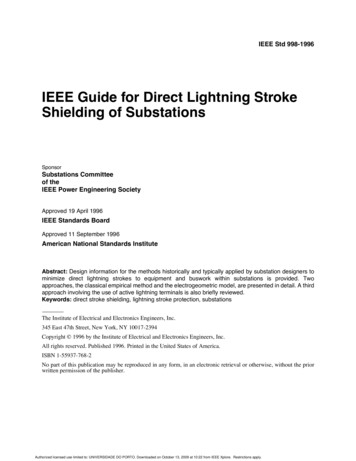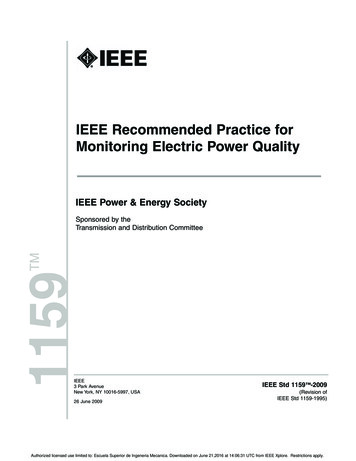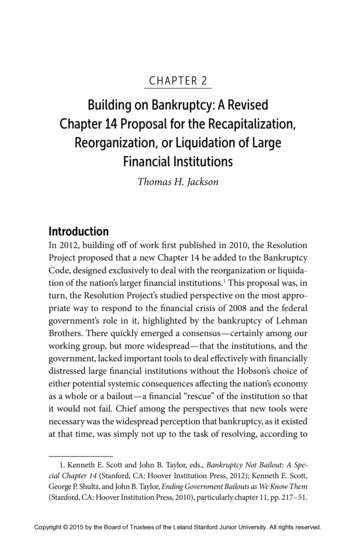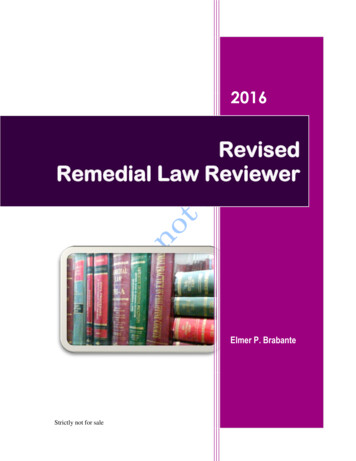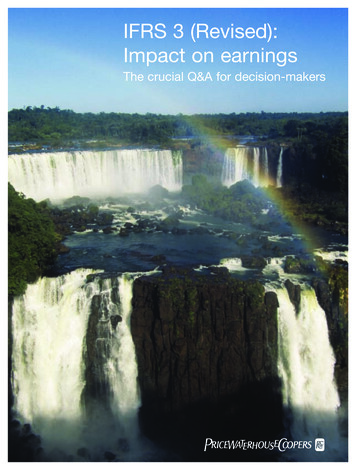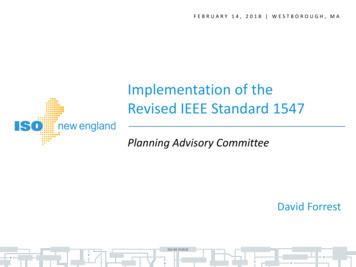
Transcription
FEBRUARY 14, 2018 WESTBOROUGH, MAImplementation of theRevised IEEE Standard 1547Planning Advisory CommitteeDavid ForrestISO-NE PUBLIC
Purpose Provide an update on standards impacting interconnection ofdistributed energy resources (DER) Discuss the need for DER performance that supports thereliability of the Bulk Electric System Discuss interim steps that will improve DER performanceISO-NE PUBLIC2
KEY POINTS OF PRESENTATIONISO-NE PUBLIC3
Key Points As New England adds significant amountsof Distributed Energy Resources (DER), itis essential for these resources to beinterconnected in a way that does notadversely impact the reliability of the BulkElectric System (BES) The revision to IEEE Standard 1547 (Standard for InterconnectingDistributed Resources with Electric Power Systems) will not be fullyimplemented until 2020 or later In this presentation, ISO-NE identifies interim requirements forperformance of solar PV DER that are required to ensure support of thereliability of the BESISO-NE PUBLIC4
BACKGROUNDISO-NE PUBLIC5
The ISO Engaged Stakeholders on DER StandardsISO-NE continues to be involved in discussions of the need forDER to support the reliability of the BESISO-NE has initiatedongoing discussions aboutthe need for updatingstate interconnectionrequirements to includeride-through for voltageand frequency excursions May 16, 2012: Planning Advisory Committee(PAC) meeting June 20, 2013: PAC meeting September 30, 2013 Distributed GenerationForecast Working Group (DGFWG) meeting December 16, 2013: DGFWG meeting January 17, 2014: Comments onMA DPU 12-76-A (Grid Modernization) January 21, 2014: DGFWG meeting April 2, 2014: DGFWG meeting April 16, 2014: MA Technical Standard ReviewGroup (TSRG) meeting July 11, 2014: PAC and DGFWG meeting May 16, 2017: TSRG meetingISO-NE PUBLIC6
Role of IEEE in Setting Interconnection Standards The Energy Policy Act of 2005 requires electric utilities toprovide interconnection services “based on standardsdeveloped by the Institute of Electrical and ElectronicsEngineers: IEEE Standard 1547 for Interconnecting DistributedResources with Electric Power Systems, as they may beamended from time to time.”– Public Law 109–58, August 8, 2005ISO-NE PUBLIC7
Bulk Electric System Planning Criteria ISO-NE is required to plan for the contingency loss ofresources (including DER) for conditions included in planningcriteria mandated by NERC and NPCC Planning criteria require that the transmission system remainsecure for a permanent three-phase fault with normal faultclearing– Normal clearing of a three-phase fault on the 345 kV system isapproximately 0.1 seconds– Normal clearing of a three-phase fault on a the 115 kV system canrange from 0.1 seconds to over 0.5 seconds depending on theprotective relay schemeISO-NE PUBLIC8
Bulk Electric System Planning Criteria, cont. Planning criteria also requireanalysis of a three-phasefault with delayed clearing– Delayed clearing of a threephase fault on the 345 kVsystem is approximately 0.1-0.2seconds– Delayed clearing of a threephase fault on a the 115 kVsystem can range from 0.3seconds to over a seconddepending on the protectiverelay schemeISO-NE PUBLIC9
Limitations on the Loss of Source Planning criteria for stability analysis require limitations onthe amount of sources that be lost for a contingency Historically, the concern has been large generators beingdisconnected or going unstable and tripping Tripping of DER for a transmission fault would add to sourceloss If total source loss exceeds the amount allowed by theplanning criteria, a system upgrade would be requiredISO-NE PUBLIC10
Effect on the New England System In a 12/16/13 stakeholder presentation, ISO-NE described itsreliability concern that New England may lose significantamounts of DER due to transmission faults*– This presentation shows how a fault on the transmission system cancause low voltage over a large portion of the New England system ISO-NE recommended the following capabilities for DER:––––––High/low frequency ride-throughHigh/low voltage ride-throughDefault and emergency ramp rate limitsReconnect by “soft start” methodsVoltage supportCommunication capabilities* See: comm wkgrps/othr/distributed generation frcst/2013mtrls/dec162013/dg transmission impacts.pdf.ISO-NE PUBLIC11
Concern at the NERC Level The North American Electric Reliability Corporation (NERC)has expressed increasing concern with the impact of DERs onBES reliability In February 2017 NERC issued a report* “Distributed EnergyResources, Connection Modeling and ReliabilityConsiderations” NERC’s report supportsthe need for the DERcapabilities identified byISO-NE* See: distributed energy resources report.pdfISO-NE PUBLIC12
Concern at the NERC Level, cont. NERC’s report also describes autonomous inverterfunctionalities that will be added to California’s technicaloperating standards in Rule 21 by the end of 2017– Support anti-islanding to trip off under extended anomalousconditions– Provide ride-through of low/high voltage excursions beyond normallimits– Provide ride-through of low/high frequency excursions beyond normallimits– Provide volt/VAR control through dynamic reactive power injectionthrough autonomous responses to local voltage measurements– Define default and emergency ramp rates as well as high and lowlimits– Provide reactive power by a fixed power factor– Reconnect by “soft-start” methodsISO-NE PUBLIC13
ISO New England is ForecastingSignificant Solar Growth The following three slides arefrom the Final 2017 PV Forecast*– Massachusetts accounts for more than60% of of the projected PV MW– Massachusetts’ forecast is projectedto more than double in the next decade Each year the projections increase for the amount of DER inNew England thus making DER impact on the BES reliability alarger concern* See: distributed-generation-forecastISO-NE PUBLIC14
ISO is Forecasting Continued Solar PV GrowthOver the Next DecadePV Nameplate MW acSource: Final PV Forecast (April 2017); * Note: MW values are AC nameplateISO-NE PUBLIC15
Final 2017 PV ForecastNameplate Capacity, MWacSource: Final PV Forecast (April 2017); * Note: MW values are AC nameplateISO-NE PUBLIC16
PV Growth: Reported Historical vs. ForecastISO Updates the Forecast Annually to Capture Policy ChangesISO-NE PUBLIC17
STATUS OF IEEE 1547 AND UL 1741ISO-NE PUBLIC18
IEEE 1547 IEEE 1547, IEEE Standard for Interconnecting Distributed Resourceswith Electric Power Systems, was originally issued in 2003 (15472003). In 2013, Amendment 1 was approved (IEEE 1547a) to allow rangesof settings for tripping distributed resources for abnormal voltageand frequency. Amendment 1 also allowed settings to regulatevoltage with the agreement of the interconnecting utility. In December 2013, IEEE started the process to do a completerevision to IEEE 1547. In 2017, the revised IEEE 1547 was balloted and approved. The standard was then updated to address comments from theballoters, was re-balloted and approved by a greater margin.ISO-NE PUBLIC19
IEEE 1547, cont. The approved revision to 1547 is undergoing final editing at IEEEand should be published by the second quarter of 2018 Before DER can be certified as meeting the revised 1547, the testingstandard 1547.1 must be revised Work on 1547.1 is ongoing and will optimistically be completed bythe end of 2018 Once 1547.1 is approved, UL 1741 will need to be updated to agreewith the revised 1547.1 Once UL 1741 is updated and approved, it will take a year or longerfor all inverter manufacturers to have their inverters tested andcertified Thus, it will be 2020 or possibly later before utilities will be able touse the revised IEEE 1547ISO-NE PUBLIC20
UL 1741 UL 1741 is the UL Standard for Safety for Inverters,Converters, Controllers and Interconnection SystemEquipment for Use With Distributed Energy Resources The second edition was dated January 28, 2010 UL 1741 was revised as of September 7, 2016 to incorporatethe new supplement SA UL 1741 SA defines the requirements for “Grid Support UtilityInteractive Inverters” These inverters have the capabilities required by CaliforniaRule 21 (see slide 13) and that meet ISO-NE needs As of September 9, 2017 inverter-based generation inCalifornia is required to be certified as meeting UL 1741 SAISO-NE PUBLIC21
INTERIM SOLUTIONISO-NE PUBLIC22
Interim Solution Because of the rapid growth of solar PV in New England andthe timeline for full implementation of the revision to IEEE1547, ISO-NE sought out an interim solution for obtainingride-through for voltage and frequency variations Inverters meeting the requirements of UL 1741 SA have thecapabilities required by ISO-NE Choosing performance requirements for these invertersrequired the input from distribution engineers, solar PVdevelopers and inverter manufacturers ISO-NE worked with the Massachusetts Technical StandardsReview Group (TSRG) to get input from these entitiesISO-NE PUBLIC23
Interim Solution, cont. The TSRG is an existing group tasked with addressingdistribution interconnection issues The TSRG includes representatives from utilities, developers,manufacturers and Massachusetts regulators Over 60% of solar PV in New England is/will be installed inMassachusetts The TSRG includes representatives from Eversource, whichalso has subsidiaries in Connecticut and New Hampshire The TSRG includes representatives from National Grid, whichalso has a subsidiary in Rhode IslandISO-NE PUBLIC24
Interim Solution, cont. Development of inverter performance requirements and animplementation plan required addressing multiple issues––––––Transmission reliabilityDistribution protectionRetaining maximum trip timeAnti-islanding protectionConformance with the revised IEEE 1547Allowing time for manufacturers to develop software to implementISO-NE settings Balancing these and other issues, ISO-NE and the TSRGdeveloped a Source Requirements Document and animplementation plan– A summary followsISO-NE PUBLIC25
Interim Solution (developed with the MA TSRG) The Inverter Source Requirements Document of ISO-NE (ISONE SRD) contains additional details on the application of “GridSupport Utility Interactive Inverters”– Also posted with this PAC meeting’s materials– A Source Requirements Document can be used by to certify thatequipment meets a specific set of requirements– The ISO-NE SRD can be used with the existing UL 1741 SA All inverter-based solar PV projects 100 kW or less withapplications submitted on or after June 1, 2018 are subject tothe ISO-NE SRDISO-NE PUBLIC26
Interim Solution (developed with the MATSRG), cont. All inverter-based solar PV projects greater than 100 kW, withapplications submitted on or after March 1, 2018, are subjectto the ISO-NE SRD Inverter-based solar PV projects with applications submittedprior to the above dates are encouraged to comply with theISO-NE SRD with the approval of the interconnecting utilityISO-NE PUBLIC27
Interim Solution (developed with the MATSRG), cont. ISO-NE will require the following frequency trip settings whichare consistent with the allowable ranges of the revised 1547and with NPCC requirements:Shall Trip FunctionOF2OF1UF1UF2Default Settings (b)Frequency (Hz)Clearing Time(s)620.166130058.530056.50.16ISO-NE PUBLIC28
Interim Solution (developed with the MATSRG), cont. The frequency trip settings will result in the following ridethrough capabilityFrequency Range(Hz)f 62.0Operating ModeMinimum Time(s)(design criteria)No ride-through requirements apply to this range61.2 f 61.8Mandatory Operation297-30058.8 f 61.2Continuous OperationInfinite57.0 f 58.8Mandatory Operation297-300f 57.0No ride-through requirements apply to this rangeISO-NE PUBLIC29
Interim Solution (developed with the MATSRG), cont. ISO-NE will require the following voltage trip settings whichare consistent with the allowable ranges in Category II of therevised 1547Shall TripShall Trip Function(OV OvervoltageUV Undervoltage)OV2OV1UV1UV2Voltage(per unit of nominalvoltage)1.201.100.880.50ISO-NE PUBLICClearing Time(s)0.162.02.01.130
Interim Solution (developed with the MATSRG), cont. The voltage trip settings will result in the following ridethrough capabilityVoltage Range(p.u.)Operating Mode/ResponseRange of Ride-through Time(s)(min – max)V 1.20Cease to EnergizeN/A1.175 V 1.20Permissive Operation0.2 – 2.01.15 V 1.175Permissive Operation0.50 – 2.01.10 V 1.15Permissive Operation1.00 – 2.00.88 V 1.10Continuous OperationInfinite0.65 V 0.88Mandatory Operation1.84 – 2.00.50 V 0.65Mandatory Operation0.32 – 2.0V 0.50Momentary Cessation(with a maximum response timeof 0.083 seconds)0.16 – 1.1ISO-NE PUBLIC31
NEXT STEPSISO-NE PUBLIC32
Next Steps ISO-NE will work with utilities and regulators in each state toimplement the ISO-NE SRD– Having one SRD for all of New England will minimize developer’s costs– Having one SDR will simplify modeling DER in planning studies ISO-NE will work with utilities to optimize the utilization ofadvanced inverter functions that will be available under the revisedIEEE 1547 ISO-NE will work with utilities and regulators to specify the IEEE1547 category that will be assigned to each type of DER (thesecategories are described in the Appendix) ISO-NE will work with Municipal Utilities and Co-ops to implementthe ISO-NE SRD on their systems Utilities should evaluate joining EPRI’s project “Navigating DERInterconnection Standards and Practices”ISO-NE PUBLIC33
ISO-NE PUBLIC34
APPENDIXIEEE 1547 Categories For Response to Abnormal ConditionsISO-NE PUBLIC35
IEEE 1547 Categories IEEE 1547 is technology neutral and thus does not establishperformance requirements for specific DER techno
IEEE 1547, cont. The approved revision to 1547 is undergoing final editing at IEEE and should be published by the second quarter of 2018 Before DER can be certified as meeting the revised 1547, the testing standard 1547.1 must be revised Work on 1547.1 is ongoing and will optimistically be completed by the end of 2018File Size: 827KBPage Count: 40People also search forreference point of applicability ieee 1547iso-ne ieee 1547-2018massachusetts iso-ne ieee 1547-2018ieee 1547 2018connecting single phase solar inverter to t connecting single phase inverter to three p


